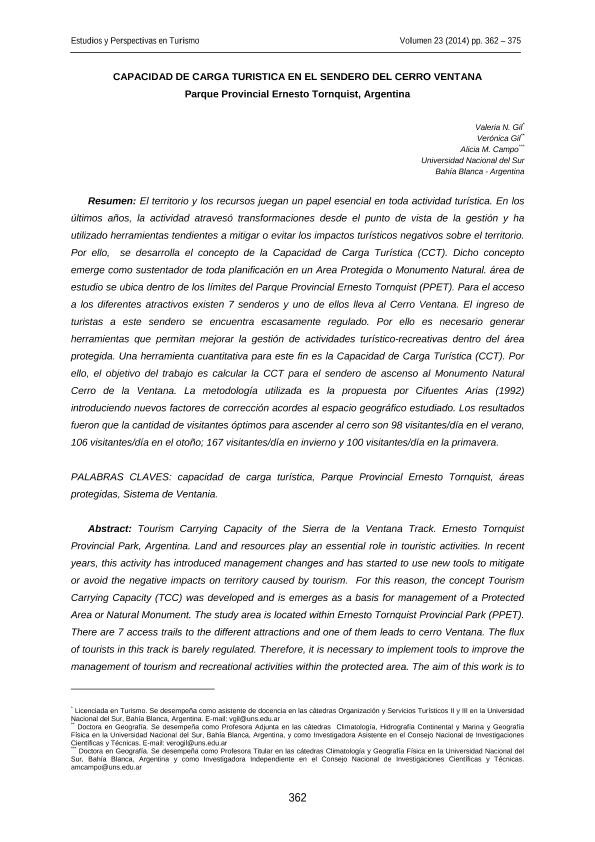Artículo
El territorio y los recursos juegan un papel esencial en toda actividad turística. En los últimos años, la actividad atravesó transformaciones desde el punto de vista de la gestión y ha utilizado herramientas tendientes a mitigar o evitar los impactos turísticos negativos sobre el territorio. Por ello, se desarrolla el concepto de la Capacidad de Carga Turística (CCT). Dicho concepto emerge como sustentador de toda planificación en un Area Protegida o Monumento Natural. área de estudio se ubica dentro de los límites del Parque Provincial Ernesto Tornquist (PPET). Para el acceso a los diferentes atractivos existen 7 senderos y uno de ellos lleva al Cerro Ventana. El ingreso de turistas a este sendero se encuentra escasamente regulado. Por ello es necesario generar herramientas que permitan mejorar la gestión de actividades turístico-recreativas dentro del área protegida. Una herramienta cuantitativa para este fin es la Capacidad de Carga Turística (CCT). Por ello, el objetivo del trabajo es calcular la CCT para el sendero de ascenso al Monumento Natural Cerro de la Ventana. La metodología utilizada es la propuesta por Cifuentes Arias (1992) introduciendo nuevos factores de corrección acordes al espacio geográfico estudiado. Los resultados fueron que la cantidad de visitantes óptimos para ascender al cerro son 98 visitantes/día en el verano, 106 visitantes/día en el otoño; 167 visitantes/día en invierno y 100 visitantes/día en la primavera. Tourism Carrying Capacity of the Sierra de la Ventana Track. Ernesto Tornquist Provincial Park, Argentina. Land and resources play an essential role in touristic activities. In recent years, this activity has introduced management changes and has started to use new tools to mitigate or avoid the negative impacts on territory caused by tourism. For this reason, the concept Tourism Carrying Capacity (TCC) was developed and is emerges as a basis for management of a Protected Area or Natural Monument. The study area is located within Ernesto Tornquist Provincial Park (PPET). There are 7 access trails to the different attractions and one of them leads to cerro Ventana. The flux of tourists in this track is barely regulated. Therefore, it is necessary to implement tools to improve the management of tourism and recreational activities within the protected area. The aim of this work is to calculate the Tourism Carrying Capacity for the trail to access Cerro Ventana. The method used is the one proposed by Cifuentes Arias (1992). New correction factors were introduced according to the characteristics of the zone studied. The results of the application of this methodology in the cerro Ventana trail showed that the ideal number of visitors is 98 visitors/day in summer, 106 visitors/day in fall, 167 visitors/day in winter and 100 visitors/day in spring.
Capacidad de carga turística en el sendero del Cerro Ventana: Parque Provincial Ernesto Tornquist, Argentina
Título:
Tourism carrying capacity of the Sierra de la Ventana track: Ernesto Tornquist provincial park, Argentina
Fecha de publicación:
04/2014
Editorial:
Centro de Investigaciones y Estudios Turísticos
Revista:
Estudios y Perspectivas en Turismo
ISSN:
0327-5841
e-ISSN:
1851-1732
Idioma:
Español
Tipo de recurso:
Artículo publicado
Clasificación temática:
Resumen
Archivos asociados
Licencia
Identificadores
Colecciones
Articulos(CCT - BAHIA BLANCA)
Articulos de CTRO.CIENTIFICO TECNOL.CONICET - BAHIA BLANCA
Articulos de CTRO.CIENTIFICO TECNOL.CONICET - BAHIA BLANCA
Citación
Gil, Valeria Natalia; Gil, Veronica; Campo, Alicia María; Capacidad de carga turística en el sendero del Cerro Ventana: Parque Provincial Ernesto Tornquist, Argentina; Centro de Investigaciones y Estudios Turísticos; Estudios y Perspectivas en Turismo; 23; 2; 4-2014; 362-375
Compartir




